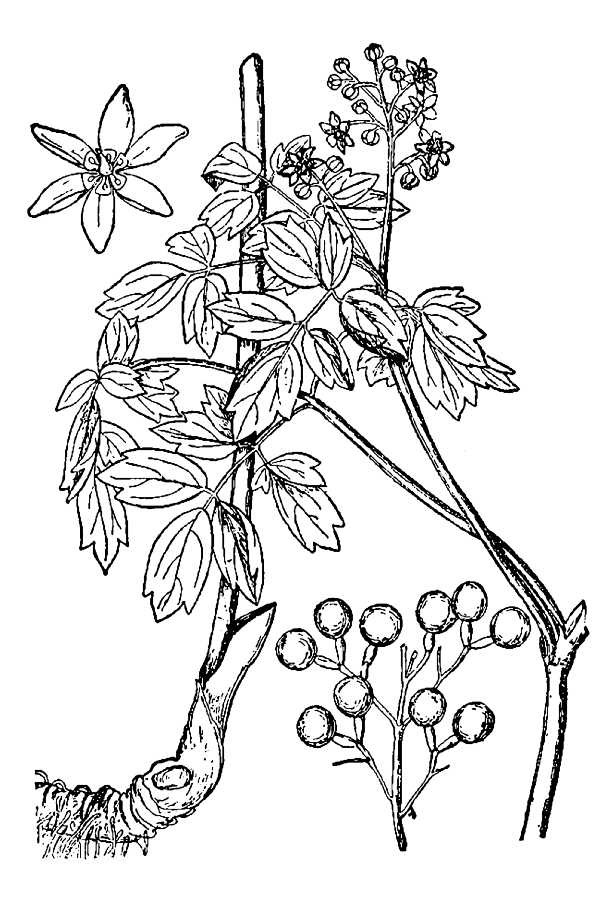- Caulophyllum
Taxobox
name = "Caulophyllum thalictroides"

image_width = 240px
image_caption = "Caulophyllum thalictroides" from Britton & Brown 1913
regnum =Plant ae
divisio = Magnoliophyta
classis =Magnoliopsida
ordo =Ranunculales
familia =Berberidaceae
genus = "Caulophyllum"
genus_authority = Michx.
subdivision_ranks = Species
subdivision = "Caulophyllum thalictroides""Caulophyllum robustum""Caulophyllum giganteum""Caulophyllum" is a small
genus of perennial herbs in the familyBerberidaceae . It is native to easternAsia and easternNorth America . These plants are distinctive spring wildflowers, which grow in moist, rich woodland, it is known for its large triple-compound leaf , and large blue, berry-likefruit s. Unlike many spring wildflowers, it is not anephemeral plant and persists throughout much of the summer. Common names for plants in this genus include Blue Cohosh, Squaw Root, and Papoose Root. As hinted at by its common names, this plant is well known as analternative medicine for inducingchildbirth and menstrual flow; it is also considered apoison ous plant.> [http://www.ars-grin.gov/cgi-bin/duke/ethnobot.pl?ethnobot.taxon=Caulophyllum%20thalictroides Dr. Duke's Phytochemical and Ethnobotanical Databases] ]Description
These large, smooth plants (0.3–0.9 m tall) have a single to few stems with each stem bearing normally one, but on large stems two, large triple-compound leafs which the casual observer might assume to be several smaller leaves arranged on three separate branches. Each leaflet ends in three to five distinct tips. Plants produce under ground stems called
rhizome s that give rise to the leaves each spring and in the fall when the foliage dies back a scar is left on the rhizome and a new bud is formed that will grow into the foliage next spring. Plants are long lived and can live for more than 50 years, they are found in wooded locations with moisture retentive soils.In April or May, each mature stem bears a spike of
flower s. Each flower has six petal-likesepal s which range from greenish-yellow to purple. The different rates of maturity between thestamen s and thepistil insures cross pollination. There are six fleshynectar glands at the base of eachsepal which attractpollinator s. Each fertilized flower matures into a large (1 cm) deep-blue berry-like fruit which houses two bitterseed s. The large seeds are covered with a characteristic blue coat and the fruits remain on the plants until fall. Seed germination can take a few years and the seedlings are hypogeal, the cotyledons remaining underground after germination and seedling emergence, the seedlings need a few years of growth before they are large enough to flower.Species
All species in this genus are very similar. Until recently, this genus was considered to be composed of only two species, however the
Flora of North America recognizes "Caulophyllum giganteum", as a distinct species rather than a subspecies of "Caulophyllum thalictroides". [ [http://www.efloras.org/florataxon.aspx?flora_id=1&taxon_id=105942 Flora of North America: Caulophyllum] ] "Caulophyllum giganteum" is slightly larger, has a more northerly (but overlapping) distribution, and blooms two weeks earlier than "Caulophyllum thalictroides". "Caulophyllum giganteum" also has fewer flowers, that are consistently purplish.*"
Caulophyllum thalictroides " -Blue Cohosh (E. North America)
*"Caulophyllum giganteum" -Giant Blue Cohosh (E. North America)
*"Caulophyllum robustum" -Asian Blue Cohosh (Japan, E. Asia)Uses
These poisonous plants has been used for many things throughout history, the three similar species generally have similar properties and uses.> [http://www.pfaf.org/database/plants.php?Caulophyllum+thalictroides Plants for a Future Database: Caulophyllum thalictroides] ] This plant is occasionally used in woodland gardens as an ornamental. Children should not be allowed to eat the attractive blue fruits, as these plants contain
chemicals that are known to cause cell damage. [ [http://www.cbif.gc.ca/pls/pp/ppack.info?p_psn=117&p_type=all&p_sci=sci&p_x=px Canadian Poisonous Plants Information System: Caulophyllum] ] The powdered roots have been shown to causedermatitis and irritation of themucus membrane s.Food
Historically, the roasted seeds have been used as a
coffee substitute; this beverage does not containcaffeine . [ [http://www.ars-grin.gov/cgi-bin/npgs/html/taxon.pl?402531 USDA GRIN Taxonomy for Plants: Caulophyllum] ]Medicine
WARNING: This plants should not be used by pregnant women. As this is a known poisonous plant, care should be taken by anyone using this plant.
Historically the root of "Caulophyllum" has been used as a medicine for:
cancer , internalparasites ,smooth muscle function,spasm s,diuretic ,menstruation , andchildbirth . It is best known for the latter two uses. Various Native American tribes are also recorded as having used this plant for similar medicinal purposes. [ [http://herb.umd.umich.edu/herb/search.pl?searchstring=Caulophyllum+thalictroides Native American Ethnobotany Database by D. Moerman] ] While no current widely marketed medicines are based on this plant, modernherbalist s and practitioners ofalternative medicine still utilize this plant as a natural therapy. Research on the medicinal potentials of this plant are ongoing.References
Wikimedia Foundation. 2010.
